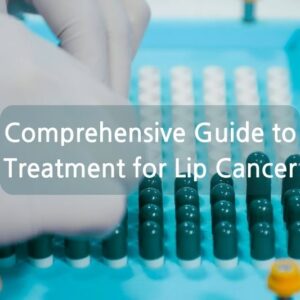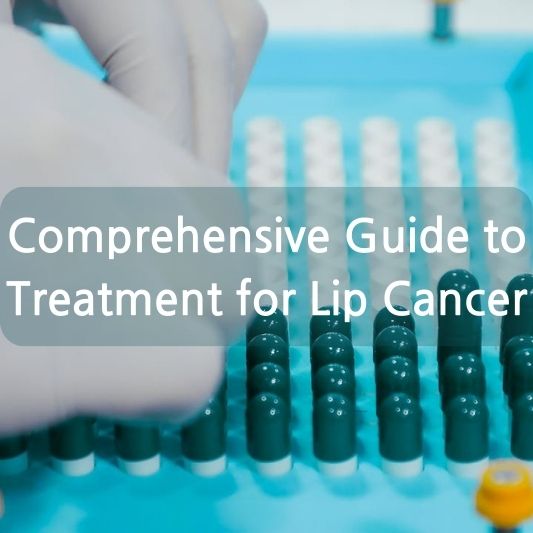Lip cancer, though relatively rare compared to other forms of cancer, can have significant implications for affected individuals. Understanding the treatment options and supportive measures available is crucial for patients and their loved ones navigating this challenging journey.

Introduction to Lip Cancer
Lip cancer refers to the abnormal growth of cells in the tissues of the lips. It can occur on the upper or lower lip and may manifest as a sore, lump, or discolored area that fails to heal. While the exact cause of lip cancer remains unclear, factors such as prolonged sun exposure, tobacco use, and alcohol consumption are known to increase the risk.
Understanding Lip Cancer: Types and Causes
Types of Lip Cancer
Lip cancer is primarily categorized into two types: squamous cell carcinoma and basal cell carcinoma. Squamous cell carcinoma is the most common form, originating in the thin, flat cells lining the lips. Basal cell carcinoma, though less frequent, also affects the lip tissues and tends to grow more slowly.
Common Causes of Lip Cancer
Several factors contribute to the development of lip cancer, including prolonged exposure to ultraviolet (UV) radiation from the sun, habitual tobacco use (including smoking and chewing tobacco), excessive alcohol consumption, and a weakened immune system. Individuals with fair skin and a history of precancerous lesions are at higher risk.
Symptoms and Early Detection
Recognizing the signs and symptoms of lip cancer is crucial for early detection and prompt treatment. These may include persistent lip sores, lumps or thickened areas on the lips, red or white patches, numbness, tingling, or pain in the lips, and difficulty moving the mouth or jaw.
Early detection increases the likelihood of successful treatment and improved outcomes. Regular self-examinations and dental check-ups play a vital role in identifying any abnormalities or changes in the lips or oral cavity.
Diagnosis Process
The diagnosis of lip cancer typically involves a comprehensive evaluation by a healthcare professional, including a physical examination, review of medical history, and specialized tests.
Physical Examination and Medical History
During the physical examination, the healthcare provider examines the lips, mouth, and surrounding tissues for any abnormalities, lesions, or signs of cancer. They may inquire about symptoms, risk factors, and personal or family medical history to assess the overall health status.
Biopsy and Imaging Tests
If suspicious areas are identified, a biopsy may be performed to obtain tissue samples for laboratory analysis. Additionally, imaging tests such as MRI, CT scan, or PET scan may be recommended to determine the extent of the cancer and assess whether it has spread to nearby lymph nodes or other organs.
Treatment Options for Lip Cancer
The choice of treatment for lip cancer depends on various factors, including the type and stage of cancer, overall health status, and patient preferences. The primary treatment modalities for lip cancer include surgery, radiation therapy, chemotherapy, and targeted therapy.
Surgery
Surgery is often the preferred treatment for early-stage lip cancer. It involves the removal of the cancerous lesion and a margin of healthy tissue to ensure complete eradication of cancer cells. Depending on the size and location of the tumor, reconstructive surgery may be performed to restore the appearance and function of the lips.
Radiation Therapy
Radiation therapy utilizes high-energy beams to target and destroy cancer cells. It may be used as a primary treatment for small or localized tumors, or in combination with surgery to eliminate residual cancer cells and reduce the risk of recurrence.
Chemotherapy
Chemotherapy involves the use of powerful medications to kill cancer cells or inhibit their growth and spread. While less commonly used for lip cancer compared to other types of cancer, chemotherapy may be recommended in cases where the cancer has spread to other parts of the body or as adjuvant therapy following surgery or radiation.
Targeted Therapy
Targeted therapy employs drugs or other substances to interfere with specific molecules involved in the growth and progression of cancer cells. By targeting these molecular pathways, targeted therapy aims to disrupt the cancer’s ability to proliferate and spread while minimizing damage to healthy tissues.
Recovery and Rehabilitation
Following treatment for lip cancer, patients require comprehensive support and rehabilitation to optimize recovery and restore oral function. This may include specialized wound care, speech therapy, dietary modifications, and dental interventions to address any functional or cosmetic concerns.
Lifestyle Changes and Prevention
Adopting healthy lifestyle habits and preventive measures can help reduce the risk of developing lip cancer. These include:
- Limiting sun exposure and using sunscreen or lip balm with UV protection
- Avoiding tobacco products and moderating alcohol consumption
- Eating a balanced diet rich in fruits, vegetables, and whole grains
- Practicing good oral hygiene and attending regular dental check-ups
Support and Coping Strategies
Dealing with a cancer diagnosis can be emotionally and psychologically challenging for patients and their families. Seeking support from friends, family members, support groups, or mental health professionals can provide valuable coping strategies and emotional resilience during this difficult time.
Research and Innovations in Lip Cancer Treatment
Ongoing research and clinical trials continue to explore novel treatment approaches and therapeutic strategies for lip cancer. From immunotherapy and targeted drug therapies to advancements in surgical techniques and radiation technology, these innovations hold promise for improving treatment outcomes and quality of life for patients.
Costs and Insurance Coverage
The cost of treating lip cancer can vary depending on the type and duration of treatment, healthcare facility, insurance coverage, and geographical location. Patients are encouraged to inquire about financial assistance programs, insurance coverage options, and potential out-of-pocket expenses to alleviate financial burdens associated with treatment.
Prognosis and Survival Rates
The prognosis for lip cancer depends on various factors, including the stage of cancer at diagnosis, the effectiveness of treatment, and individual patient factors. With early detection and timely intervention, the prognosis for lip cancer is generally favorable, with high survival rates and the potential for long-term remission.
Case Studies and Patient Stories
Real-life experiences of individuals diagnosed with lip cancer can provide valuable insights into the challenges and triumphs associated with the disease. By sharing their stories of resilience, courage, and hope, patients and survivors inspire others facing similar journeys to seek support, advocate for their health, and maintain a positive outlook.
The Importance of Regular Check-ups
Regular follow-up appointments and surveillance are essential components of post-treatment care for lip cancer survivors. These appointments allow healthcare providers to monitor for any signs of recurrence or new developments and intervene promptly to address any concerns.
Raising Awareness and Advocacy Efforts
Raising awareness about the risk factors, symptoms, and treatment options for lip cancer is vital for early detection and prevention. Public education campaigns, community outreach initiatives, and advocacy efforts play a crucial role in promoting oral health, reducing stigma, and advocating for equitable access to care for all individuals affected by lip cancer.
Conclusion: Empowering Patients and Promoting Health
In conclusion, the treatment for lip cancer encompasses a multidisciplinary approach aimed at eradicating cancer cells, preserving oral function, and improving quality of life for affected individuals. By prioritizing early detection, adopting healthy lifestyle habits, accessing timely and appropriate treatment, and seeking support from healthcare professionals and support networks, patients can navigate the challenges of lip cancer with resilience and hope.
FAQs (Frequently Asked Questions)
Can lip cancer be prevented?
While certain risk factors for lip cancer, such as sun exposure and tobacco use, can be mitigated through lifestyle changes, not all cases can be prevented. Regular screenings and early detection remain essential.
What are the long-term side effects of lip cancer treatment?
Long-term side effects of lip cancer treatment may include changes in oral sensation, difficulty swallowing or speaking, and cosmetic alterations. Rehabilitation therapies and support services can help manage these effects.
Is lip cancer hereditary?
While genetic factors may play a role in some cases of lip cancer, the majority of cases are attributed to environmental exposures and lifestyle habits.
How often should I undergo dental check-ups if I have a history of lip cancer?
Patients with a history of lip cancer should undergo regular dental check-ups at least every six months to monitor for any signs of recurrence or oral health concerns.
What should I do if I notice changes in my lips or oral cavity?
If you notice any persistent changes, abnormalities, or symptoms in your lips or oral cavity, such as sores, lumps, or discoloration, it is important to seek prompt evaluation and medical attention from a healthcare professional.
